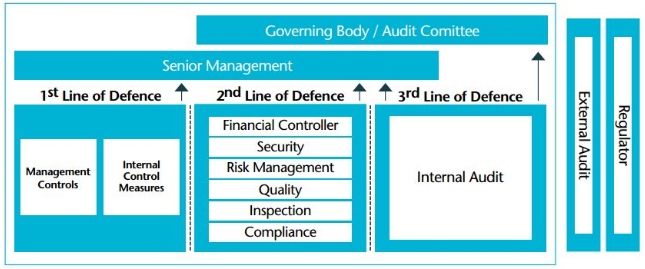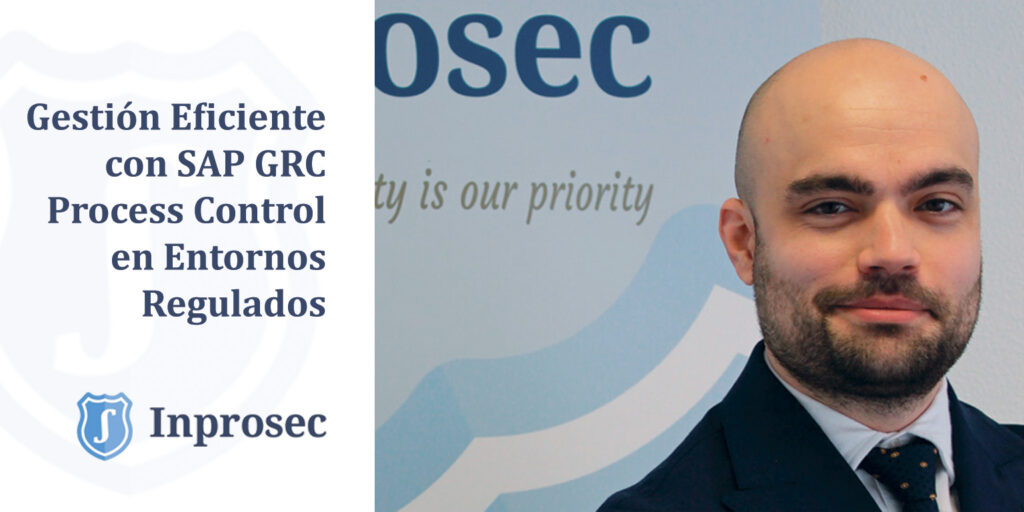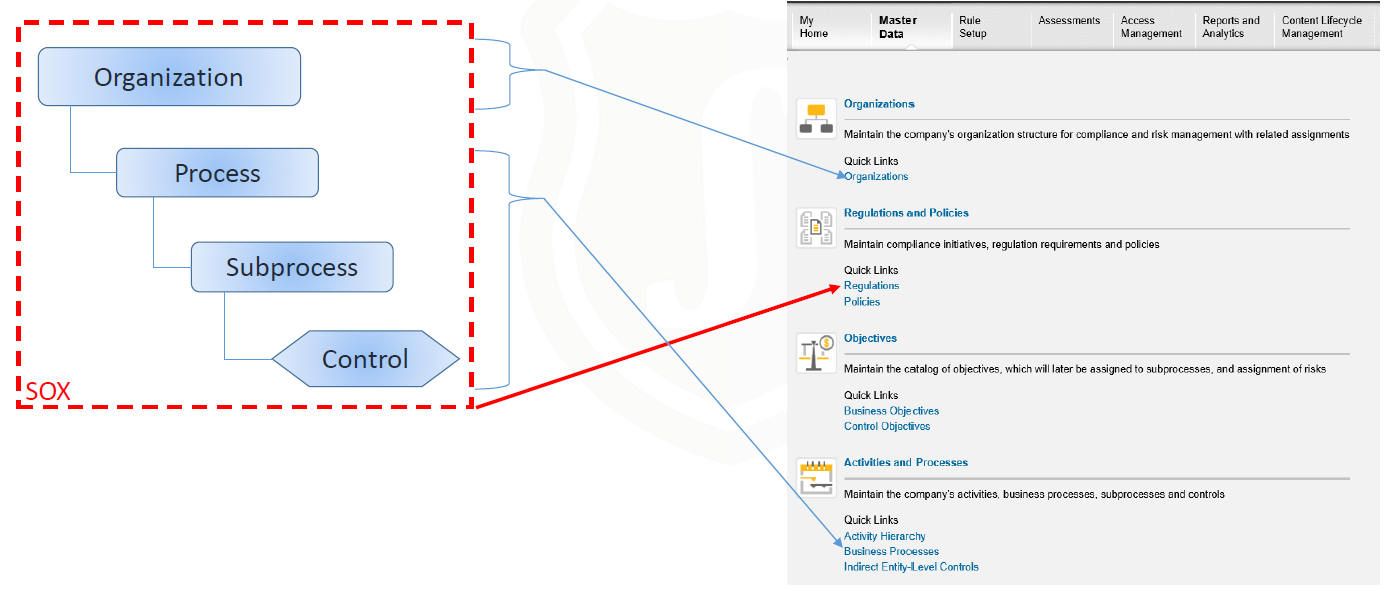In an increasingly regulated and complex environment, organizations face the challenge of finding the best solution to effectively manage and document their controls in order to comply with various applicable regulations.
The “three lines of defense” model for risk management enables organizations to define and manage their risks and compliance levels. The Institute of Internal Auditors (IIA) endorses this model as a guide for dividing responsibilities. The three lines of defense are as follows:
First Line of Defense: Operational Management
Comprising managers and staff responsible for identifying and managing risk as part of their objectives. They must possess sufficient knowledge, skills, and authority to define and operate with various risk management policies and procedures. This requires knowledge of the company and the risks it faces.
Second Line of Defense: Risk Management, Compliance, and Oversight
Provides policies, tools, techniques, and necessary support to ensure that risk and compliance are managed in the first line of defense. Monitoring is required to assess effectiveness and ensure consistency in risk definitions and measurement.
Third Line of Defense: Independent Internal Audit
This is provided by internal audit. It should be independent of the risk management processes of the first two lines of defense, with its functions aimed at ensuring the effective functioning of the first two lines and providing guidance on improvement. It should provide an assessment, using a risk-based approach, of the effectiveness of governance, risk management, and internal control to the governing body and top management of the organization. It should also provide assurance to relevant regulators and external auditors that controls and processes are implemented and functioning effectively.

SAP GRC Process Control
SAP GRC Control is a comprehensive tool that enables effective monitoring and control of processes within a company. The target user is a company with sufficiently detailed documentation of transactions and tasks within each of its departments. This is crucial for the application of the Process Control module, as effective control cannot be applied without a clear definition of the processes and subprocesses that occur during the company’s activities.
SAP GRC Process Control supports various business processes, internal control, and internal audit activities to carry out compliance activities as required from a centralized tool. This centralization ensures that testing, certifications, policies, and associated documentation are available within a single tool.
The core functionalities of SAP GRC Process Control include:
- Control Documentation: Provides a flexible environment for defining Master Data, aligning them with different regulations, and includes the following features
-
- Organizational Structure.
- Process Catalog.
- Objectives and Control Risks.
- Control Assessment: Allows for assessments of risks and analyses, as well as planning control tests. It also enables Test of Effectiveness (ToE) of controls and records evidence and issues encountered during testing processes.
-
- Assessments.
- Test of Effectiveness.
- Automated Controls.
- Plans.
- Certification: Utilizes sign-off functionality and disclosure surveys to formalize approval management, including tracking of different issues and remediation plans.
- Reporting & Analysis: Enables comprehensive audits and a detailed log of system modifications, including documented sign-offs for independent control audits.
It’s important to note that Process Control can be used not only for IT audit procedures but also for document management and various control and risk assessments, for example, in financial auditing.
Implementation of SAP GRC Process Control
The most important considerations when implementing SAP GRC Process Control are as follows:
Initiation
Before delving into the configuration of Process Control, it is essential to understand the interaction of internal and external factors, the business benefits, and their alignment with the overall control transformation strategy. It is imperative to set realistic short- and long-term objectives to establish well-founded expectations.
Master Data Definition
The definition of Master Data is critical to the success of a Process Control implementation. Master Data has two main components: organizational hierarchy and business processes. This involves defining existing business processes and corresponding subprocesses, as well as the controls applicable to each process/subprocess.
Regarding the organizational hierarchy, it is important to determine at what level data reporting is required, whether at the company, business unit, or regional level. However, it is possible that the company has multiple reporting requirements at different organizational levels, necessitating the definition of the entire structure.
Regarding the definition of business processes, it is necessary to clarify which processes apply to the company and the controls that apply to each process.
Additionally, in SAP GRC Process Control, all controls must be assigned to a subprocess, and it should be clear which organization/business unit/region the various controls apply to.
The importance of a good definition of Master Data based on the company’s needs is crucial because it can impact the generation of different reports and the efficiency of the various functionalities to be used.
Testing and Training
During the testing and training phase of the tool, active participation of end-users is crucial. Involving key users ensures a thorough understanding and covers all necessary workflow processes. An “train the trainer” approach streamlines training. Interactive sessions supported by reference materials are key. Additionally, sufficient time should be allocated for transition, especially for master data. This strategy ensures a successful implementation and seamless adoption of the tool.
Continuous Evolution
Process Control requires constant updates to keep up with changes in the business, such as plant acquisitions, audit requirements, or the need for greater automation. This “living” quality is essential to ensure its long-term relevance. Therefore, it is imperative to consider aspects such as transitioning to support, external consultancy support with experience in such developments, lessons learned from previous experiences, and continuous improvement of the tool’s roadmap. This adaptability ensures that the tool remains effective and relevant in line with the evolving business environment.
Conclusion
In conclusion, the successful implementation of SAP GRC Process Control in a regulated and increasingly complex business environment requires careful consideration of several key aspects. The “Three Lines of Defense” approach emerges as an effective strategy for distributing responsibilities and establishing a robust structure that promotes compliance and control. The tool not only facilitates the automation and organization of controls, essential for complying with various regulations but also provides broad visibility of data generated through detailed reports. The configurability and adaptability of the tool are notable, as it can be customized to meet the specific needs of each company.
During the implementation process, it is crucial to address several strategic points. Setting clear objectives and aligning them with the company’s overall strategy establishes a solid foundation. Precise definition of processes and responsibilities, supported by a well-defined Master Data structure, plays an essential role in the tool’s effectiveness. Active involvement of key employees in testing and training phases ensures successful adoption and a deep understanding of the tool. Furthermore, continuous updating and adaptation of SAP GRC Process Control to stay in tune with business changes are vital for long-term success. Collectively, the tool not only effectively addresses regulatory challenges but also empowers organizations to maintain compliance and control in an ever-evolving business environment.




